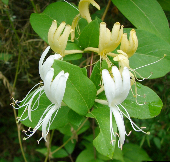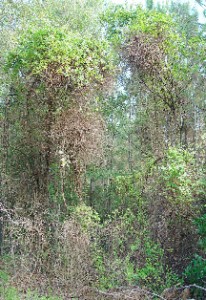Japanese Honeysuckle
Lonicera japonica
Japanese Honeysuckle
Native origin: Japan and Korea
Purposefully introduced into the U.S. in the mid-1800’s as a graceful and fragrant ground cover, and still occasionally recommended for erosion control and deer browse, Japanese honeysuckle now grows throughout much of the U.S.
Description: A perennial, semi-evergreen to evergreen vine that climbs by twisting its stems around vertical structures, including trunks and limbs of trees and shrubs, capable of growing and trailing to 80 feet in length. Leaves are opposite, oblong to oval and are sometimes lobed, and occur on short stalks in pairs along the stems. The intensely fragrant flowers are tubular, with five fused and lobed petals, colored white (occasionally pink) then aging to yellow, and occur in pairs along the stem at leaf junctures, from April to August. Stems and leaves sometimes are covered in fine hairs. Small fruits appear in autumn, aging from green to black when ripe. Japanese honeysuckle is the only honeysuckle which does not have red berries. Birds eat the berries and disperse the seeds.
Habitat: Thrives is a variety of habitats and soils, including fields, forests, wetlands and disturbed areas. It is shade tolerant. Capable of both seed and vegetative reproduction. Ecological Impacts: The semi-evergreen nature allows it to begin growth earlier in the spring and continue later in cold weather — an up to 10-week additional growing period helps the vines out compete nearly all other plants. Trees and shrubs may be girdled by the strangling vines. Dense growth of honeysuckle covering vegetation can prevent other plants from blooming or setting seed, and, over time, can kill other plants by blocking sunlight. Japanese honeysuckle roots grow vigorously to help the plant spread and can displace and replace neighboring vegetation.
Control and Management: Careful monitoring and repeat control methods may be required over a number of years for effective eradication. New plants may grow because of remaining seed stock and reintroduction of seed by birds.
Manual and Mechanical: Small patches can be hand-pulled, taking care to remove the entire plant and roots from moist soil. This is the best method to use when working near wetlands or streams to prevent herbicide drainage into water and resultant damage to reptiles and amphibians. Large roots that cannot be removed from the soil can be cut and daubed with herbicide. For large patches in suitable sites, repeated mowing and/or tilling have been effective controls.
Chemical: Effective control with herbicides can be accomplished so long as healthy green leaves are present and plant activity is ongoing at application time. Treatment in the fall or very early spring when nontarget plants are dormant but honeysuckle is active is best. Foliar spray with systemic herbicides such as glyphosate (Roundup) or triclopyr (Garlon) is effective. Repeat applications may be necessary.
Biological: Tethered goats have been shown to remove honeysuckle growth. In this case, care must be taken to prevent the goats from escaping the target area and damaging natural areas or landscapes.
Comments are currently closed.



